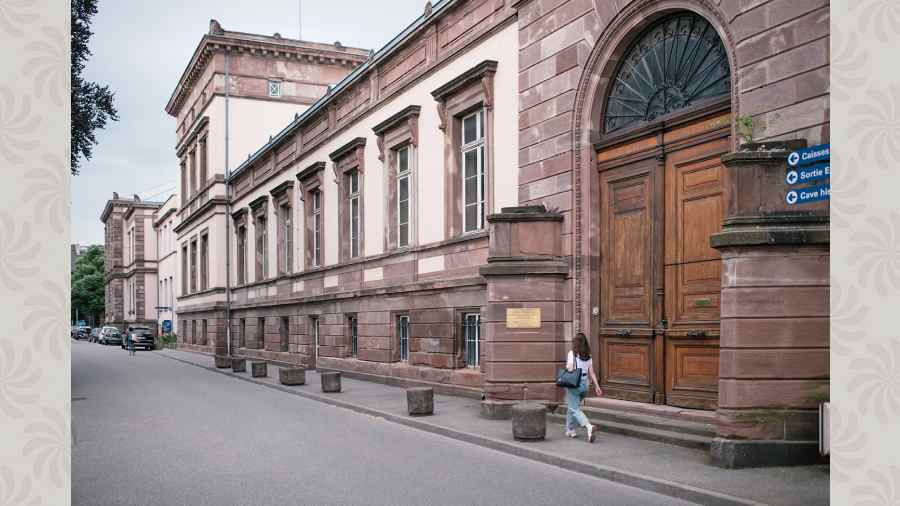For decades, students at the prestigious University of Strasbourg in France swapped rumours that human remains from Nazi victims, preserved as anatomical or pathological specimens, were still somewhere on campus.
There was reason for suspicion. When Germany annexed the Alsace region of France in 1940, it had poured in money and resources to transform the university into a model Nazi institution: the Reichsuniversität Strassburg.
From 1941 to 1944, professors on the medical faculty there forced at least 250 people from concentration camps to undergo experiments, some involving chemical weapons like mustard gas or deadly diseases like typhus. Eighty-six Jews, brought from Auschwitz, were murdered at a nearby camp for a planned skeleton collection.
But a full account of what transpired during those years was hard to come by.
“The medical faculty’s position was, ‘This is not our history’,” said Christian Bonah, a medical historian at the university, whose pre-war faculty and students had evacuated before Germany invaded. A widespread view, he said, was that “the walls are innocent” — regardless of what Nazis had done within them.
Now, though, that refusal to confront the past is being challenged. In May, the university released a 500-page report that deeply recasts the way it views itself and states out loud what had previously only been whispered: that people from Alsace had worked at the Reichsuniversität, too; that the medical crimes its professors committed were extensive; and that the school had worked closely with a nearby concentration camp.
The report had been commissioned by the university in 2016, prompted by the controversy that broke out when anatomical remains of a Nazi victim were found in a storage closet. A dozen highly qualified international scholars, most of them specialising in the history of medicine or Nazism, worked meticulously for more than five years. They dusted off boxes of documents and remnants of anatomy or pathology collections that, unwittingly or not, had been left in basements, attics and storage rooms around campus — even, in one case, hidden in a drop ceiling. They found about 10,000 clinical records, analysed nearly 300 medical dissertations, pored over 1,50,000 pages of files in archives around the globe and created a collaborative database.
The committee found that the university had closer ties than previously thought with the Natzweiler-Struthof concentration camp, near Strasbourg, where detainees and people transferred from other camps like Auschwitz were experimented on. Over the course of the war, 52,000 people were detained there, of whom 20,000 died. It was the only concentration camp on French soil.
In 2015, when a book claimed that there were still anatomical remains of Jewish victims on campus, furious school officials denied it. But that same year, Raphael Toledano, a Jewish doctor in Strasbourg researching the Nazi period, found a letter written by Camille Simonin, a medical examiner and professor.
Simonin had autopsied the bodies of the 86 Jews who were murdered in 1943 at a gas chamber at the Natzweiler-Struthof camp, at the behest of August Hirt, an anatomist at the university, to create a collection of skeletons meant to exemplify the Nazi ideology on a hierarchy of races.
The bodies were discovered in tanks in the basement of the anatomy department when Strasbourg was liberated in 1944. In his letter, Simonin wrote that he had preserved some remains as proof to assist prosecutors in postwar trials.
In July 2015, Toledano found those remains in a locked storage room at the university’s forensics institute. Controversy ensued, leading to the commission’s creation. Toledano left the committee in 2018 after some internal disagreements. Nevertheless, he praised the report.
They found more than 1,000 of Hirt’s microscopic slides, as well as 134 tissue samples or organs like kidneys or brains kept in jars, but no evidence that they were connected to criminal experiments. It also confirmed Toledano’s identification of more than 230 Russians who died in prison camps and whose bodies were used for anatomical research.
The report sheds new light on crimes committed by three professors at the Reichsuniversität’s medical faculty who used the camp to procure experiment subjects: Hirt, Eugen Haagen and Otto Bickenbach.
It was already known that four Sinti detainees died after Bickenbach experimented on them with phosgene, a combat gas used during World War I, but the commission identified 36 others. It also identified seven victims of Hirt’s mustard gas experiments and 196 victims of Haagen’s research on a typhus vaccine.
Experts stressed that these Nazi researchers followed scientific methods without any ethical guardrails but were not pseudoscientists — the Environmental Protection Agency used data from Birkenbach’s tests as late as 1988.
NYTNS










